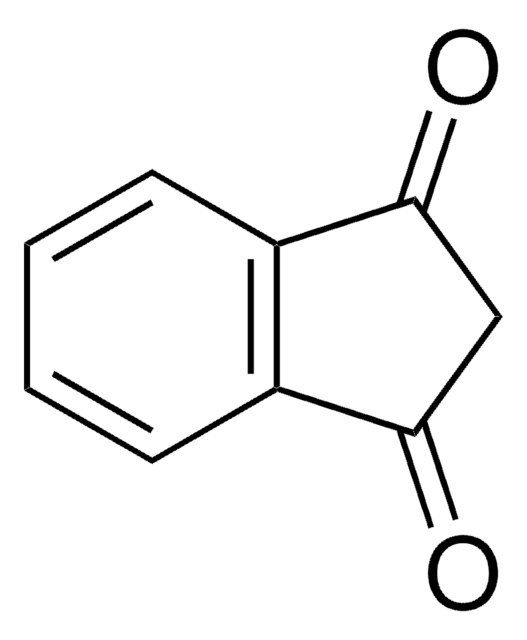38490
5,5-Dimethyl-1,3-cyclohexanedione
for HPLC derivatization, for the determination of aldehyde formaldehyde, ≥99.0%
Synonym(s):
Dimedone, Methone
Sign Into View Organizational & Contract Pricing
All Photos(1)
About This Item
Linear Formula:
(CH3)2C6H6(=O)2
CAS Number:
Molecular Weight:
140.18
Beilstein/REAXYS Number:
471489
EC Number:
MDL number:
UNSPSC Code:
12164500
PubChem Substance ID:
NACRES:
NA.21
Recommended Products
grade
for HPLC derivatization
Quality Level
assay
≥99.0% (GC)
≥99.0%
quality
for the determination of aldehyde formaldehyde
mp
146-148 °C (lit.)
application(s)
general analytical
SMILES string
CC1(C)CC(=O)CC(=O)C1
InChI
1S/C8H12O2/c1-8(2)4-6(9)3-7(10)5-8/h3-5H2,1-2H3
InChI key
BADXJIPKFRBFOT-UHFFFAOYSA-N
Looking for similar products? Visit Product Comparison Guide
General description
5,5-dimethyl-1,3-cyclohexanedione (Dimedone) is basically a highly sensitive and very specific reagent used for the determination of aldehydes. It is highly advantageous as it is environment friendly, give high yields and is a simple workup procedure.
Application
5,5-dimethyl-1,3-cyclohexanedione may be used in condensation reaction with aromatic aldehyde in ethylene glycol. It may be also be used in trace analysis of aldehydes by HPLC.
Storage Class
11 - Combustible Solids
wgk_germany
WGK 2
flash_point_f
Not applicable
flash_point_c
Not applicable
ppe
Eyeshields, Gloves, type N95 (US)
Choose from one of the most recent versions:
Already Own This Product?
Find documentation for the products that you have recently purchased in the Document Library.
Customers Also Viewed
Solid-State Condensation Reactions Between Aldehydes and 5, 5-Dimethyl-1, 3-cyclohexanedione by Grinding at Room Temperature.
Tong-shou J
Synthetic Communications, 35 (17), 2339-2345 (2005)
Jesse C Patterson et al.
Cell systems, 8(2), 163-167 (2019-02-25)
Although elevated levels of reactive oxygen species (ROS) have been observed in cancer cells and cancer cells aberrantly proliferate, it is not known whether the level of reactive oxygen species and the accumulation of oxidative damage to macromolecules vary across
Trace analysis of aldehydes by reversed-phase high-performance liquid chromatography and precolumn fluorigenic labeling with 5, 5-dimethyl-1, 3-cyclohexanedione.
Kenneth M
Journal of Chromatography A, 256, 243-252 (1983)
Kimberly J Nelson et al.
Methods in enzymology, 473, 95-115 (2010-06-02)
Reversible thiol modification is a major component of the modulation of cell-signaling pathways by reactive oxygen species. Hydrogen peroxide, peroxynitrite, or lipid hydroperoxides are all able to oxidize cysteines to form cysteine sulfenic acids; this reactive intermediate can be directly
Katie E Crump et al.
European journal of immunology, 42(8), 2152-2164 (2012-06-08)
B-cell receptor (BCR) ligation generates reactive oxygen intermediates (ROIs) that play a role in cellular responses. Although ROIs can oxidize all macromolecules, it was unclear which modifications control B-cell responses. In this study, we demonstrate the importance of the first
Our team of scientists has experience in all areas of research including Life Science, Material Science, Chemical Synthesis, Chromatography, Analytical and many others.
Contact Technical Service











